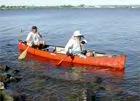|
|
Canku Ota |
|
|
(Many Paths) |
||
|
An Online Newsletter Celebrating Native America |
||
|
August 11, 2001 - Issue 42 |
||
|
|
||
|
Canoe Trip Commemorates Chippewa Tribes Sandy Lake Tragedy |
||
|
Story and Photo by Jennifer Simonson Ashland Daily Press-July 27, 2001 |
 Jim Schlender
and Neil Kmiecik are praying for good weather this week. They'll need it in order to complete an ambitious journey
by canoe from Madeline Island in the Apostle Islands to Duluth, and up the St. Louis River to Fond du lac. Jim Schlender
and Neil Kmiecik are praying for good weather this week. They'll need it in order to complete an ambitious journey
by canoe from Madeline Island in the Apostle Islands to Duluth, and up the St. Louis River to Fond du lac.The two men are making the trek to commemorate the journey of representatives from 19 Chippewa tribes from Wisconsin and Michigan who set out 150 years ago on the journey to Sandy Lake, just north of MacGregor in Aitkin County. Exhausted, the tribal representatives arrived at Sandy Lake, only to find that promised annuity payments had been delayed and there were no provisions to replace their depleted supplies. They waited at Sandy Lake from mid-October to Dec. 2. While they waited, about 150 Chippewa people died from dysentery and measles. Once they realized their miserable journey had been for naught, they started back, walking this time because their canoes were useless on the frozen rivers. Another 230 to 250 people died on their way home, weak from malnutrition and suffering from the harsh elements. The Sandy Lake Tragedy marked a turning point in the U.S. government philosophy of dealing with the Native Americans. The incident led key players in Washington to change the policy of trying to move the Indians and instead shifted the focus of negotiations toward establishing reservations. "It's a tragic story," Jim Schlender, executive administrator of the Great Lakes Fish and Wildlife Commission, said. "It's a sad story. But it's also, in many ways, a story that demarcates a line from a policy of removal, of getting Indians out of the way of white settlement, to one of a policy of creating reservations within the boundaries of states, within boundaries of the nation. It's a decidedly different policy choice for the federal government. It's a policy that has endured to the present. It forms the basis and the core of a permanent homeland for First Americans for American Indians." Events to commemorate the Sandy Lake Tragedy began last weekend at Madeline Island, where Native Americans gathered to dedicate a granite monument erected there to mark the location of the beginning of the journey for many of the men who left their families and village for the long journey to get their annuity payments. Schlender and Kmiecik left the shores of Madeline Island on Friday. They plan to arrive in Duluth in time to portage the rest of the way to Sandy Lake, then return to their canoes to paddle to the west bank of the lake where another granite monument stands marking the site where hundreds died waiting for promised payments that never came. "We hope to paddle 20 miles a day" Schlender said. "We have a couple extra days in there in the event that wind or waves or weather prevent us from paddling on any one day. We plan to paddle commencing at sunrise every day and paddling as far as endurance and weather, wind and waves will permit." On July 29, another gathering will take place to dedicate the Sandy Lake monument, to feast and to send off a group of runners that will make the return journey to Madeline Island on foot. "The memorial would serve as a reminder to the inhabitants of this country of that particular chapter in our joint history," Schlender said. "The feast has cultural significance, one of the traditions in which we remember those who have passed away. In this case we remember those 400 Anishinabe that died at Sandy Lake and on the return trip from Sandy Lake." Schlender says the weekend's events and the monuments serve to increase public awareness of what happened at Sandy Lake, not to lay blame. "I don't think that in all of the process of creating that there was ever any intent to lay guilt or blame upon people," he said. "That is not the basis upon which our relationship stands. The basis upon which our relationship stands is far stronger than that. It's rooted in the Constitution of this country. It's rooted in the history of this country. It's not a guilt trip. It's not a public relations ploy to try to garner reparations or to try to right things in that kind of a way. It's really a spiritual journey, a spiritual remembrance. It's part of culture to remember those of our ancestors who have passed on." |
|
|
|
Sandy Lake Tragedy |
|
Sandy Lake Memorial |
|
|
||
|
|
||
| Canku Ota is a free Newsletter celebrating Native America, its traditions and accomplishments . We do not provide subscriber or visitor names to anyone. Some articles presented in Canku Ota may contain copyright material. We have received appropriate permissions for republishing any articles. Material appearing here is distributed without profit or monetary gain to those who have expressed an interest. This is in accordance with Title 17 U.S.C. section 107. | ||
|
Canku Ota is a copyright © 2000, 2001 of Vicki Lockard and Paul Barry. |
||
|
|
|
|
|
The "Canku Ota - A Newsletter Celebrating Native America" web site and its design is the |
||
|
Copyright © 1999, 2000, 2001 of Paul C. Barry. |
||
|
All Rights Reserved. |
||

